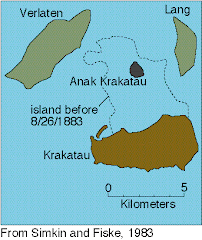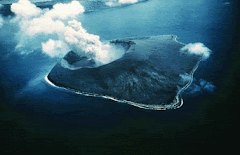Sunday, March 29, 2009
Fun Facts
- Indonesia contains over 130 volcanoes
- The 1883 explosion was equivalent to 200 megatons of TNT
- Krakatau released 18 cubic km of ash to a height of 80km
- The tsunamis produced killed about 34,000 people, and pyroclastic flows of hot ash and debris traveling at 40km killed about 2,00 people
- The sound of the Explosion was the loudest recorded in history

Anak Krakatau

Anak Krakatau really means "Child of Krakatau." Anak Krakatau first broke the surface around 1927 but eroded away. It eroded away two more times and the final immersion was in 1930. It is currently 500m high and has been rising since. Every year, Anak Krakatau rises about 6m and is currently about 200m above sea level. Its diameter measures about 2km.
Facts
Geologic Location
Country- IndonesiaNearby Cities- Java, Sumatera, and Verlaten and Lang islands
Plate/Boundary- India-Australia plate, Continental plate boundary
Type of Crust- Oceanic
Eruption History
Most Famous- August 26-27, 1883
Most Recent- August 11-17, 2008
Volcano Shape
Height-2,000 meters
Radius- 9 km
Elevation of Summit- 813 meters
Structure-Was Stratovolcano then Caldera
Vents/Craters/Domes-Three Major vents then one Major now, Former Craters and Now Crater, and Multiple Domes then Few now
Neighboring Volcanoes
Papandayan, Merapi, Tengger caldera, Rakata, Danan, and Perbuwatan
Eruption Style
-Very Explosive
Lava Type- Basaltic
Hazards- Debris, Pyroclastic flows, and Tsunamis
Occurrence- Frequent
Environmental Dangers/Benefits
Soil Fertility- Anak Krakatau doesn't have good fertility but ash fall on other islands due to it have had higher soil fertility
Damage to Property- Krakatau had immense damage to surrounding islands, Anak Krakatau's seismic activity creates minor damage
Atmospheric Affects- Fine fragments of tephra and dust that were propelled kilometers into the stratosphere began to make a ring around the equator. Sulfur Dioxide was ejected from the volcano and mixed with water creating sulfuric acid. The particles partially blocked the suns light and the temperature of the Earth was lowered for a few years.
Krakatau's Most Famous Eruption

The morning of May 20, 1883, residents of the neighboring islands noticed a cloud of ash and dust rising in the air about 11 km high. The cloud lasted for about two months. This was an awe intensifying spectacle for all who saw, but little did they now, this was the prelude to Krakatau's biggest eruption. On August 16, 1883 it was about mid-day when suddenly Krakatau released a series of cataclysmic explosions lasting till the next day. Krakatau ended with a stupendous paroxysmal eruption. This last eruption was so big, it blasted two thirds of beneath the sea. This generated a series of pyroclastic flows and tsunamis. In all, about 36,000 people died.
Sources
Bubb, Michael. "Krakatoa." http://www.earlham.edu. 18 Apr. 2004. 27 Mar. 2009 http://www.earlham.edu/~bubbmi/krakatoa.htm.
"Krakatau." http://www.photovolcanica.com. 27 Mar. 2009 http://www.photovolcanica.com/VolcanoInfo/Krakatau/Krakatau.html.
"Krakatau." http://www.volcano.si.edu. Smithsonian National Museum of National History. 23 Mar. 2009 http://www.volcano.si.edu/world/ volcano.cfm?vnum=0602-00=.
"KRAKATAU, INDONESIA (1883)." http://www.geology.sdsu.edu. 27 Mar. 2009 http://www.geology.sdsu.edu/how_volcanoes_work/Krakatau.html.
Lane, Frank W. The Elements Rage. Philedelphia: Frank W. Lane, 1965.
Pararas-Carayannis, George. "THE KRAKATAU VOLCANO IN INDONESIA ON AUGUST 26-27, 1883." http://www.drgeorgepc.com. 25 Mar. 2009 http://www.drgeorgepc.com/Tsunami1883Krakatau.html.
"Krakatau." http://www.photovolcanica.com. 27 Mar. 2009 http://www.photovolcanica.com/VolcanoInfo/Krakatau/Krakatau.html.
"Krakatau." http://www.volcano.si.edu. Smithsonian National Museum of National History. 23 Mar. 2009 http://www.volcano.si.edu/world/ volcano.cfm?vnum=0602-00=.
"KRAKATAU, INDONESIA (1883)." http://www.geology.sdsu.edu. 27 Mar. 2009 http://www.geology.sdsu.edu/how_volcanoes_work/Krakatau.html.
Lane, Frank W. The Elements Rage. Philedelphia: Frank W. Lane, 1965.
Pararas-Carayannis, George. "THE KRAKATAU VOLCANO IN INDONESIA ON AUGUST 26-27, 1883." http://www.drgeorgepc.com. 25 Mar. 2009 http://www.drgeorgepc.com/Tsunami1883Krakatau.html.
Subscribe to:
Posts (Atom)



